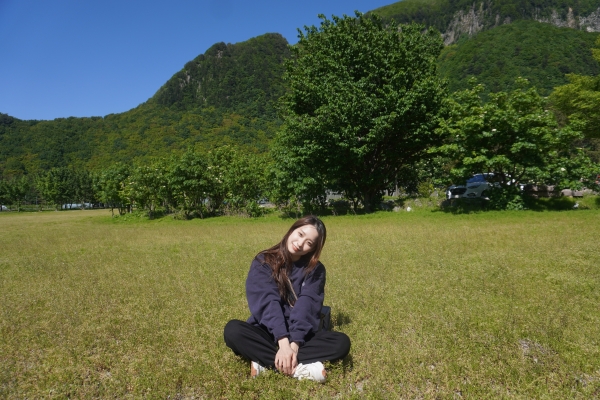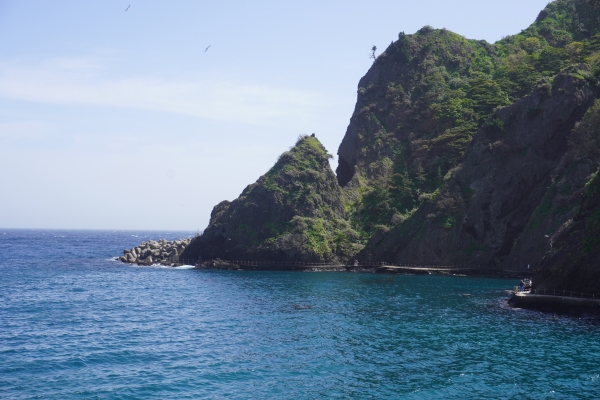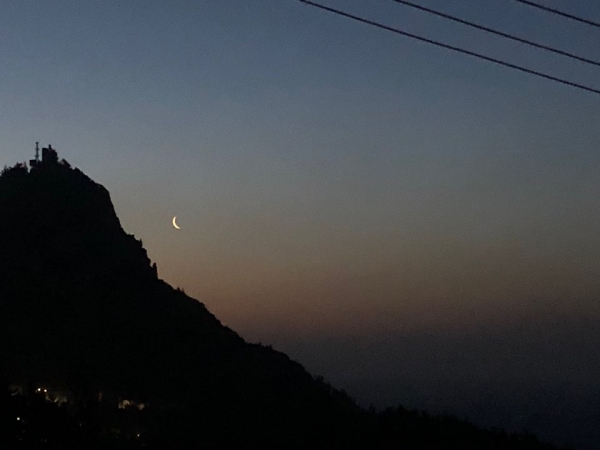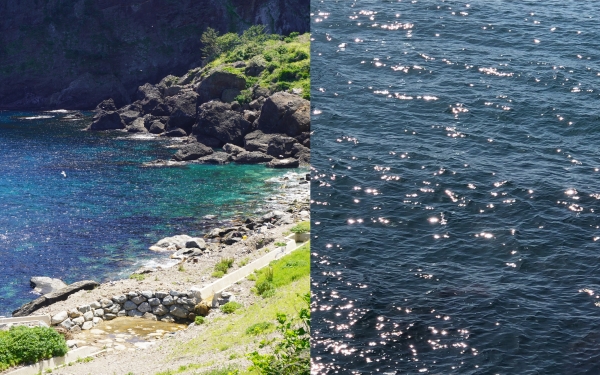From May 7 to 9, Ewha Voice took a trip with Dokdo Academy to publicize Korea’s sovereignty over Dokdo. Dokdo is one of Korea’s miraculous islands, filled with marine resources and beautiful scenery. Located on the east coast of South Korea, Dokdo is an integral part of Korea's territory historically and geographically. Ewha Voice reporters share the experience and knowledge they acquired during the program.
A record of three days on Ulleungdo with the Dokdo Academy

It was around 9:50 a.m. on May 7 when we gathered at the Gyeongbokgung Palace. The rain got heavier by the minute, making it unclear whether boarding a ship to Ulleungdo and Dokdo would even be possible. From the palace, a harsh journey of six hours took us to Uljin, a district in North Gyeongsang Province.
After arriving at a hotel in Uljin, six universities in Seoul including Ewha and three universities in the suburbs gathered at the hotel’s conference room for an orientation. With nine schools together, we made up the 45th class of the Dokdo Academy.
Dokdo Academy is an educational organization established in 2007 to provide education and training sessions about Dokdo to teenagers andundergraduate students. The academy usually invites students majoring in education or those working in university newspapers who can share what they have learned during the program with the public. This year, the General Committee Chairperson of Education and Training in Dokdo Academy,Park Chang-woo, announced that they mainly contacted English university newspapers like Ewha Voice to spread awareness about the territorial dispute over Dokdo to international students visiting Korea.
We were able to see the progress that Dokdo Academy has made over the 13 years since its establishment. The institution has been endeavoring to remove terms like “Takeshima” or “Sea of Japan,” which describe the Korean territory of Dokdo as if it were part of Japan. Kim Chang-nam, a professor at Kyunghee University, gave a short lecture on why Koreans should study the significance of Dokdo and exert its sovereignty over the island.
Professor Kim explained that the official record of Dokdo in Korea stretches back to the year 1145. “Samguk Sagi,” which is a chronological record of three kingdoms in ancient Korea, states how “Usanguk,” a term used to refer to the Ulleungdo and Dokdo area at the time, was subjugated by General Isabu of the Silla dynasty in 512. This is the earliest Korean historical reference to Dokdo as Korean territory.
Even Japan themselves wrote in “Dai Nihon Enkai Yochi Zenzu,” their most extensive and detailed map of the Japanese territories published in 1821, that Ulleungdo and Dokdo are lands of Korea. The map was composed of five documents, all of which depicted that Dokdo belongs not to Japan, but to the Joseon Dynasty.
Despite the historical references, we were shocked to see that over 97 percent of the maps in 60 countries referred to the East Sea as “Sea of Japan” and Dokdo as “Takeshima.” With such figures, Professor Kim urged all Koreans, especially young students like us, to spread awareness that Dokdobelongs to Korea.
The next day, on May 8, we headed to Hupo Harbor, a major port with access to Ulleungdo and Dokdo. We prepared to board a ship to Ulleungdo at 10 a.m. Due to the size of the waves, we were given medicine for nausea to intake before departure. It took two hours and 50 minutes to get from Uljin to Ulleungdo by ship. A number of participants were hoping to see the beautiful scenery of the island, but we were unable to get a clear view of Ulleungdo due to the bad air quality that day. Yet, the rocky faces surrounding the island and stereoscopic sounds of the waves were enough for us to realize that we had finally arrived at Ulleungdo.
Although sailing to Dokdo Island was not possible due to turbulent marine conditions, we saw fascinating landscapes on Ulleungdo and several public institutions that gave us valuable information about Dokdo.
One of the main events during the trip was the visit to the Dokdo Museum. Founded on Aug. 8, 1997, the Dokdo Museum is currently endeavoring to emphasize that Dokdo is undoubtedly the territory of Korea by educating and exhibiting diverse historical documented evidence as well as Dokdo’s natural landscape and its cultural heritage.
Consisting of five permanent and thematic exhibition halls and the motion picture room, the Dokdo Museum conveys a wide range of information about Dokdo. The museum displays “Samguk Sagi,” which Professor Kim had mentioned as the oldest evidence of Dokdo being the territory of Korea. Along with this evidence, it exhibited other historical proofs such as the “Cheonha chongdo,” a map of Gangwondo Province indicating Ulleungdo and Usan (present-day Dokdo).
Additionally, the museum provided the history of Japan’s illegal occupation of Dokdo and their exploitation of marine resources in the waters around the island while gaining a strategic advantage in the impending Russo- Japanese War.
On the last day of our trip, we visited the Dokdo Volunteer Forces Memorial Hall, which was established in order to contribute to the Dokdo Volunteer Forces and to promote a spirit of guardianship and national defense.
The hall is unique in that it was built with volcanic stones in the shape of Dokdo’s eastern and western islands. The exhibition highlights the great influence of the 33 Defenders of Dokdo including Captain Hong Sun- Chil. It commemorates their persistent and courageous efforts during their fight against Japan’s illegal invasion of Dokdo from April 20, 1953 to December 30, 1956.
Exhibition arts such as a Dokdo model, a real time video of Dokdo, medals and certificates awarded to the 33 defenders, and the handwritten manuscript of Captain Hong were displayed along with other various models which reenacted the past life on the island.
Operating Dokdo Academy: Importance of Dokdo education

Park Chang-woo, who led the Dokdo Academy program, explained how the academy was first formed. When Japan insisted that Dokdo was Takeshima, a nongovernmental organization Dokdo Network emerged to denounce Japan’s historical distortion. For the last 14 years, the organization has been trying to deliver proper historical knowledge.
“Our mission is to change the land’s official name from Takesima to Dokdo,” he said. “We also hope to foster a young generation of international protectors with a strong will to secure Dokdo.”
Although it is difficult going to Dokdo, he is certain that the experience of visiting Dokdo will change people’s thoughts about the importance of protecting it. Park also emphasized the significance of Dokdo education for future generations.
“Having a correct sense of history cannot be emphasized enough as ignorance can easily lead to a repetition of tragic history,” he noted. “Therefore, the country should provide an environment where students can learn about the history according to their will, instead of solely leaving it up to civic organizations. In order for the education to develop into a more professional and systematic process, universities should adopt Dokdo education as a regular subject.”
Dokdo Academy is providing education for high school and university students so they can grow up to be intellectuals who can take action. The academy believes the experience of going to Dokdo is indeed a basic duty of a Korean student.
Jang MiSeon, a reporter at DJU NEWS, a student newspaper at Daejeon University, participated as the assistant manager of the 45th class of Dokdo Academy. It was Jang’s third time attending Dokdo Academy.
As an applicant for the 41st class of Dokdo Academy, she first succeeded in visiting Dokdo on July 2, 2019. Afterwards, Jang was selected as a university student representative for the 44th class and visited Dokdo for the second time. She is currently planning to apply for the 46th class this summer.
“Only a few students can logically explain why Dokdo is ours with historical evidence,” Jang said. “I was clearly not one of them, but as soon as Dokdo unfolded before my eyes, I felt the strong will to protect the island myself. In order to protect Dokdo, we must first become familiar with it.”
Jang emphasized the importance of history education. Before setting foot on Dokdo, she completed the preliminary education provided by DokdoAcademy. Jang visited Ahn Junggeun Memorial Museum, Maeheon Yun Bong-Gil Memorial Museum, Woodang Museum, Gyeongbokgung Palace, and Seodaemun Prison to study the history of the Japanese colonial era.
“It is pointless to claim Dokdo as our territory if we are ignorant as to the reason,” Jang said. “Dokdo is an island that holds our history from modern and contemporary history back to the year 512, during the Silla Dynasty. It is a long time frame, but studying bit by bit does help because small things come together to achieve a big objective.”
A few months ago, Jang suggested opening a three-credit liberal arts course based on Dokdo to the president of Daejeon University. The schoolresponded that it would sincerely look over the proposal.
“While participating in Dokdo Academy, I felt the need for Dokdo education to all Koreans,” Jang said. “Also, the most effective way to respond to Takeshima education is Dokdo education. The president seemed to realize the seriousness of the Dokdo territorial issue. If a lecture on Dokdo opens next year, it might be the most exciting news in my college life.”
Dokdo & Ulleungdo
Dokdo sea lions

Dokdo sea lions are sea creatures belonging to the otariidae family. They have been considered endangered since 1905, during the Japanese colonial period, when Japanese intensively overfished them for leather and oil. They were last identified on Dokdo in 1972, and were declared extinct by the International Union for Conservation of Nature (IUCN) in 1994. Japan is currently distorting the history of Dokdo by creating characters of sea lions. Japan presents the monopolistic hunting of sea lions as the evidence for sovereignty over Dokdo, but is it morally justifiable for a nation to mercilessly slaughter and exploit the animals?
Dokdo’s secret

Most people draw Dokdo as two islands: East Island and West Island. However, Dokdo actually has different numbers of peaks depending on the viewing angle. One has to actually visit Dokdo oneself to see its three peaks as well as its majestic features.
Ulleungdo, a place where people can focus solely on themselves





When local people living in Ulleungdo board a ship to mainland Korea, they say they are heading to “the land.” They are always aware of the fact that they are living in a distant island. This may be the reason why the people of Ulleungdo seem quaint and pure at the same time. Ulleungdo grants people time to enjoy themselves without any interruption, surrounded by undefiled nature.
Mystical color

The water of Ulleungdo is very clear. The harmony of the various emerald blue colors is like a painting.

